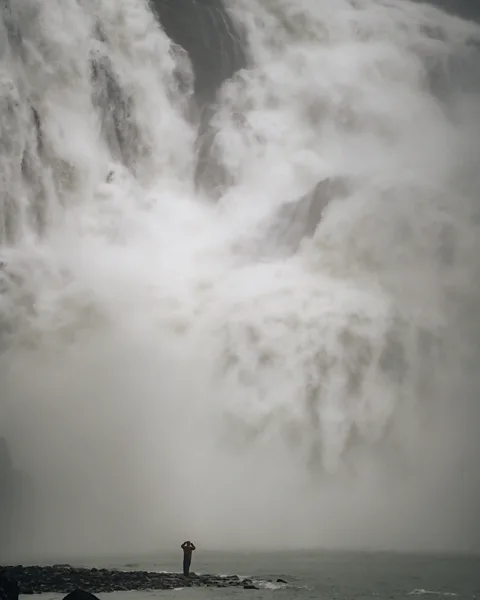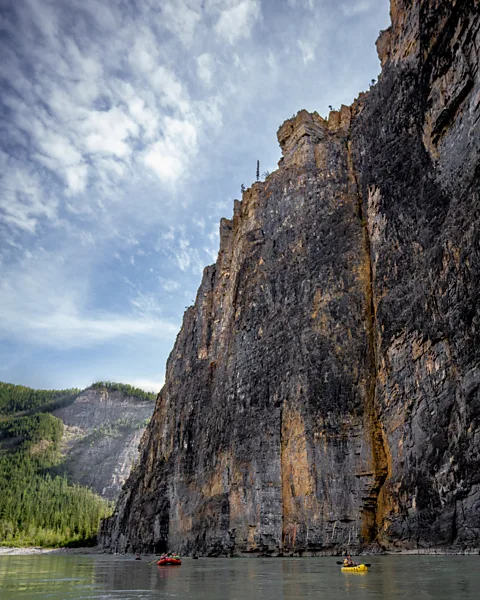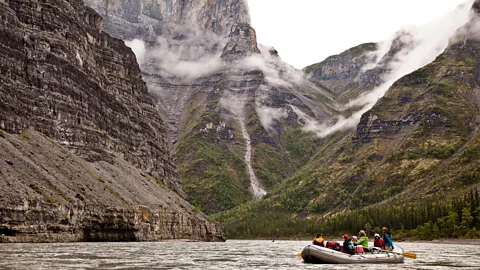Paddling the dramatic 'Grand Canyon of Canada'
 Getty Images
Getty ImagesNavigating the Nahanni River is a once-in-a-lifetime bucket list experience that reveals a remote and untouched side of Canada few travellers ever see.
"Pop these earmuffs on – you'll need them," says the co-pilot of our vintage 1967 Twin Otter floatplane, his voice barely cutting through the roar of the engines. Soaring above endless boreal forest, dramatic canyons and the mist-shrouded cascades of the thundering Virginia Falls, the plane delivers us into the wild heart of the Nahanni National Park Reserve in Canada's Northwest Territories, setting the stage for an unforgettable journey downstream.
My partner and I are here to embark on a bucket list adventure down the iconic Nahanni River. Our 11-day, 217km guided journey begins at the iconic Virginia Falls and concludes just outside the park at Nahanni Butte. This isn't a high-adrenaline whitewater journey, but rather a leisurely float down the river's winding length – an immersive experience that lets you soak in the pristine beauty of the Northwest Territories at a gentle pace. By venturing deep into the park's five lower canyons and listening as our guides share the area's Indigenous and Gold Rush-era history, each stop becomes an invitation to connect more deeply with the Nahanni's winding path and its storied past.
Ever since RM Patterson's seminal 1954 book The Dangerous River, chronicling the year the writer and explorer spent canoeing these waters, the Nahanni River has held near-mythical status among Canadian paddlers. Towering cliffs, carved over millennia, rise on either side of the water, forming canyons so breathtaking they're frequently dubbed "the Grand Canyon of Canada". For many, journeying down the Nahanni is a kind of national pilgrimage, offering a glimpse into a remote and untouched side of the country that few travellers ever experience. It's not just the dramatic canyons and thundering waterfalls, but the sense of profound wilderness and solitude.
 Jonny Bierman
Jonny BiermanAs such, getting here is no simple feat. While a handful of visitors might fly in for a day hike or a scenic flight, the heart of the Nahanni reveals itself only to those who travel by water. The trip can be self-guided or guided, and most outfitters offer multi-day rafting or canoe expeditions, ranging from a week to nearly two weeks.
For us, the lengthy travel time and cost make the 11-day itinerary more worthwhile than the shorter seven-day trip that travels the same stretch of river. This gives us more time to relax at campsites, hike scenic trails and enjoy the river's tranquility. For seasoned paddlers, there are even more ambitious routes: experienced canoeists can begin their journey with whitewater paddling and hiking at the world-renowned Cirque of the Unclimbables, combining hikes among towering granite spires and camping on the shores of Rabbitkettle Lake.
The upper reaches of the Nahanni before Virginia Falls are accessible only by canoe, and contain stretches of flat, calm water and require a vessel that glides swiftly – unlike the bulky rafts we use for our float trip further downstream. The South Nahanni is more famous for its dramatic canyons, but no matter the section, travelling the river is a journey through some of the most remote parts of Canada, where solitude isn't just a possibility but a defining feature. Fewer than 900 overnight visitors explore the park each year, and the chances of encountering anyone outside your own group are slim.
More like this:
• A rare and wild adventure on the Colorado River
Upon landing, we're greeted by our three guides from Nahanni River Adventures who are in the midst of portaging all of the gear, including deflated rafts, down to the base of the falls. We soon meet Parks Canada Interpretation Officer Jaclyn Paddison, who leads us on an interpretive journey along a boardwalk above Virginia Falls. The elevated wooden path winds through stunted boreal forest to a lookout, where two Parks Canada Red Chairs offer the perfect spot to relax and take in the awe-inspiring view. Across from us, Mason's Rock – a towering spire – stands defiantly as Virginia Falls thunders around it in a spectacular whitewater display.
 Jonny Bierman
Jonny BiermanPaddison explains that, in 1970, then-prime minister Pierre Elliott Trudeau paddled the Nahanni River with his two sons. At the time, a hydroelectric dam was being proposed for the area, but Trudeau's transformational journey through the foaming river as it zig-zags through the towering Mackenzie Mountains inspired him to champion its protection. By 1972, the Nahanni was designated as a national park reserve, becoming the first of its kind in Canada.
"This park holds a lot of firsts," Paddison tells us. "It was the first National Park Reserve in Canada, meaning it was established in collaboration with the Dehcho [First Nations], allowing the Dene Peoples to continue foraging and hunting on their traditional lands. It also became Canada's first Unesco World Heritage Site (in 1978), and in 2009, it was expanded to include the entire South Nahanni River watershed, making it one of the largest protected areas in the country."
Perched safely above the dramatic torrent of the falls, Paddison hands each of us a small bundle of tobacco and invites us to cast it into the wind – an offering to the Indigenous ancestors who have travelled and protected this river for thousands of years. "[The Dene Peoples] would build canoes from moose hide and travel the river in search of food – caribou, deer, moose and other staples. The river was, and still is, a lifeline [for them]."
After some bannock (Indigenous fry bread) around the fire made by the Parks staff, we spend night one at Virginia Falls Campground before setting off down the river.
 Jonny Bierman
Jonny BiermanWith Virginia Falls fading behind us, the Nahanni carries us in its current and I quickly realise I'm able to sit back, relax with camera in hand and let the Nahanni River – and the rhythm of our guides' oars – draw us deeper into its untamed embrace. Slicing through the rugged Selwyn and Mackenzie Mountains before emptying into the Liard River, these sheer rock walls rise more than 1,200m in places, creating the five canyons we will traverse during our expedition.
Unlike Patterson's swashbuckling journey, our serene paddling expedition requires no prior rafting or river experience, making it accessible to almost anyone. Fuelled by gourmet meals ranging from cinnamon buns to lamb, carrot cake cooked to perfection, steak and more – all masterfully prepared over an open fire and in a Dutch oven by our guides – it is a journey of indulgence. A portable toilet system, affectionately dubbed the "loo with a view", ensures sustainable pack-it-in, pack-it-out practices, while we set up and take down our own camping gear.
As the river carves its way through five canyons, the landscape becomes increasingly dramatic – the canyons deepening and towering higher with each passing day. One of the most striking campsites is "The Gate", a spectacular entrance to Third Canyon, where sheer cliffs rise above the water. This 32km-long canyon has formed as the river sliced through layers of shale, sandstone and limestone over the past 100 million years.
"The Nahanni River is more than just a place; it's a journey through time and connection. Every bend feels like stepping into a new world, and as you paddle, the land comes alive with stories," Indigenous river guide Bobbi Rose Koe later tells me. Dedicated to transforming the landscape of river guiding in Canada's Northwest Territories and the Yukon, including on the Nahanni, Rose Koe founded Dinjii Zhuh Adventures. When she began her guiding career in 2019, Rose Koe was struck by the lack of First Nations river guides. Determined to change that, she set up Dinjii Zhuh Adventures to serve as a training programme to empower the next generation of Indigenous leaders. Through a partnership with Nahanni River Adventures owner Joel Hibbard, Rose Koe provides First Nations guides with opportunities to work on rivers like the Nahanni. This collaboration not only increases Indigenous representation in the industry, but also creates a platform for guides to share their culture, language and stories with guests.
 Alamy
Alamy"Now, I'm training youth to not only guide, but also bring their own culture, language and stories to the river." For Rose Koe, this work is about more than just representation; it's about creating meaningful change. "People talk a lot about reconciliation, but what Joel and I have is more than that. It's about learning together and shifting how things are done – not just in our company, but across the [Northwest Territories and Yukon]."
While the Dene Peoples maintain their original placenames for the canyons they still travel, they were also named by number in reverse order by early settlers, reflecting the order they travelled upstream through. After passing through Third Canyon, our days in Second and First Canyon are filled with even more dramatic cliffs rising higher on either side of the river. A rare sighting of a lynx and later, swimming bison, combined with more hiking and swimming through a frigid canyon at the appropriately named Chasm of Chills, adds to the sense of wildness. When a fisher in the group successfully catches an Arctic Grayling, our guides fry it up for the group to enjoy.
With each bend of the river revealing ever more awe-inspiring cliffs, untamed wildlife and a profound sense of solitude, it becomes unmistakably clear why the Nahanni has earned its place among the world's great wilderness rivers.
--
If you liked this story, sign up for The Essential List newsletter – a handpicked selection of features, videos and can't-miss news, delivered to your inbox twice a week.
